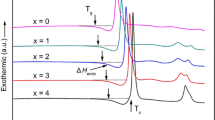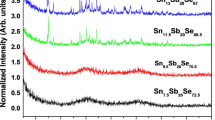Abstract
Pd80+x Si20−x (x = 0, 1, and 2) binary metallic glasses with the diameter ranging from 7 to 8 mm were prepared by a combination of fluxing and water quenching or air cooling. Thermal analysis results show that with increasing Si content, the glass transition temperature T g, the initial crystallization temperature T x and the onset crystallization temperature T p of Pd-Si binary glassy alloys increase. Moreover, the supercooled liquid region reaches 61 K. It indicates that Pd-Si binary alloys possess large glass forming ability, which can be greatly improved by fluxing treatment.
Similar content being viewed by others
References
Klement W, Willens R H, Duwez P. Non-crystalline structure in solidified gold-silicon alloys. Nature, 1960, 187: 869–870
Turnbull D. Under what conditions can a glass be formed? Contemp Phys, 1969, 10: 473–488
Greer A L. Metallic glasses. Science, 1995, 267: 1947–1953
Kui H W, Greer A L, Turnbull D. Formation of bulk metallic glass by fluxing. Appl Phys Lett, 1984, 45(6): 615–616
Inoue A, Zhang T, Masumoto T. Al-La-Ni amorphous alloys with a wide supercooled liquid region. Mater Trans JIM, 1989, 30(12): 965–972
Kim S G, Inoue A, Masumoto T. High mechanical strengths of Mg-Ni-Y and Mg-Cu-Y amorphous alloys with significant supercooled liquid region. Mater Trans JIM, 1990, 31(11): 929–934
Inoue A, Zhang T, Masumoto T. Zr-Al-Ni amorphous alloys with high glass transition temperature and significant supercooled liquid region. Mater Trans JIM, 1990, 31(3): 177–183
Inoue A. High-strength bulk amorphous-alloys with low critical cooling rates. Mater Trans JIM, 1995, 36: 866–875
Inoue A. Stabilization of metallic supercooled liquid and bulk amorphous alloys. Acta Mater, 2000, 48: 279–306
Johnson W L. Bulk glass-forming metallic alloys: Science and technology. MRS Bull, 1999, 24: 42–56
Wang W H, Dong C, Sheck C H. Bulk metallic glasses. Mater Sci Eng, 2004, R44: 24–89
Wang D, Li Y, Sun B B, et al. Bulk metallic glass formation in the binary Cu-Zr system. Appl Phys Lett, 2004, 84: 4029–4031
Xu D, Lohwongwatana B, Duan G, et al. Bulk metallic glass formation in binary Cu-rich alloy series-Cu100−x Zrx (x = 34, 36, 38.2, 40 at%) and mechanical properties of bulk Cu64Zr36 glass. Acta Mater, 2004, 52: 2621–2624
Tang M B, Zhao D Q, Pan M X, et al. Binary Cu-Zr bulk metallic glass. Chin Phys Lett, 2004, 21: 901–903
Yao K F, Ruan F. Pd-Si binary bulk metallic glass prepared at low cooling rate. Chin Phys Lett, 2005, 22: 1481–1483
Pu J, Wang J F, Xiao J Z, et al. Formation of Pd82Si18 bulk metallic glass and its crystallization. J Huazhong Univ Sci Tech, 2003, 31: 69–72
Yao K F, Ruan F, Yang Y Q, et al. Superductile bulk metallic glass. Appl Phys Lett, 2006, 88: 122106
Xia L, Li W H, Fang S S, et al. Binary Ni-Nb bulk metallic glasses. J Appl Phys, 2006, 99: 026103
Wang J G, Choi B W, Nieh T G, et al. Crystallization and nanoindentation behavior of a bulk Zr-Al-Ti-Cu-Ni amorphous alloy. J Mater Res, 2000, 15(3): 798–807
Greer A L, Castellero A, Madge S V, et al. Nanoindentation studies of shear banding in fully amorphous and partially devitrified metallic alloys. Mater Sci Eng A, 2004, 375–377: 1182–1185
Schuh C A, Nieh T G. A nanoindentation study of serrated flow in bulk metallic glasses. Acta Mater, 2005, 51: 87–99
Greer A L, Walker I T. Transformations in primary crystallites in (Fe,Ni)-based metallic glasses. Mater Sci Forum, 2002, 386–388: 77–88
Tang C G, Li Y, Zeng K Y. Characterization of mechanical properties of a Zr-based metallic glass by indentation techniques. Mater Sci Eng A, 2004, 384(1–2): 215–223
Lu Z P, Liu C T. Glass forming criterion for various glass systems. Phys Rev Lett, 2003, 91: 115505
Inoue A, Nishiyama N. Extremely low critical cooling rates of new Pd-Cu-P base amorphous alloys. Mater Sci Eng, 1997, A226–228: 401–405
Chen N, Yao K F, Ruan F. Influence of flux treatment on the glass forming ability of Pd-Si binary alloy. J Univ Sci Tech Beijing, 2007, 14(suppl 1): 4–7
Chen N, Yao K F, Ruan F. The influence of cooling rate on the hardness of Pd-Si binary glassy alloys. Mater Sci Eng, 2007, A473: 274–278
Yao K F, Zhang C Q. Fe-based bulk metallic glass with high plasticity. Appl Phys Lett, 2006, 90: 061901
Hong S Y, Guo W H, Kui H W. Metastable liquid miscibility gap in Pd-Si and its glass forming ability (III). J Mater Res, 1999, 14: 3668–3672
Lee K L, Kui H W. Phase separation in undercooled molten Pd80Si20 (I). J Mater Res, 1999, 14: 3653–3662
Lee K L, Kui H W. Crystallization of undercooled liquid spinodals (II). J Mater Res, 1999, 14: 3663–3667
Author information
Authors and Affiliations
Corresponding author
Additional information
Supported by the National Basic Research Program of China (Grant No. 2007CB613905) and the National Natural Science Foundation of China (Grant Nos. 50671050 and 50431030)
Rights and permissions
About this article
Cite this article
Yao, K., Chen, N. Pd-Si binary bulk metallic glass. Sci. China Ser. G-Phys. Mech. As 51, 414–420 (2008). https://doi.org/10.1007/s11433-008-0051-4
Received:
Accepted:
Published:
Issue Date:
DOI: https://doi.org/10.1007/s11433-008-0051-4




